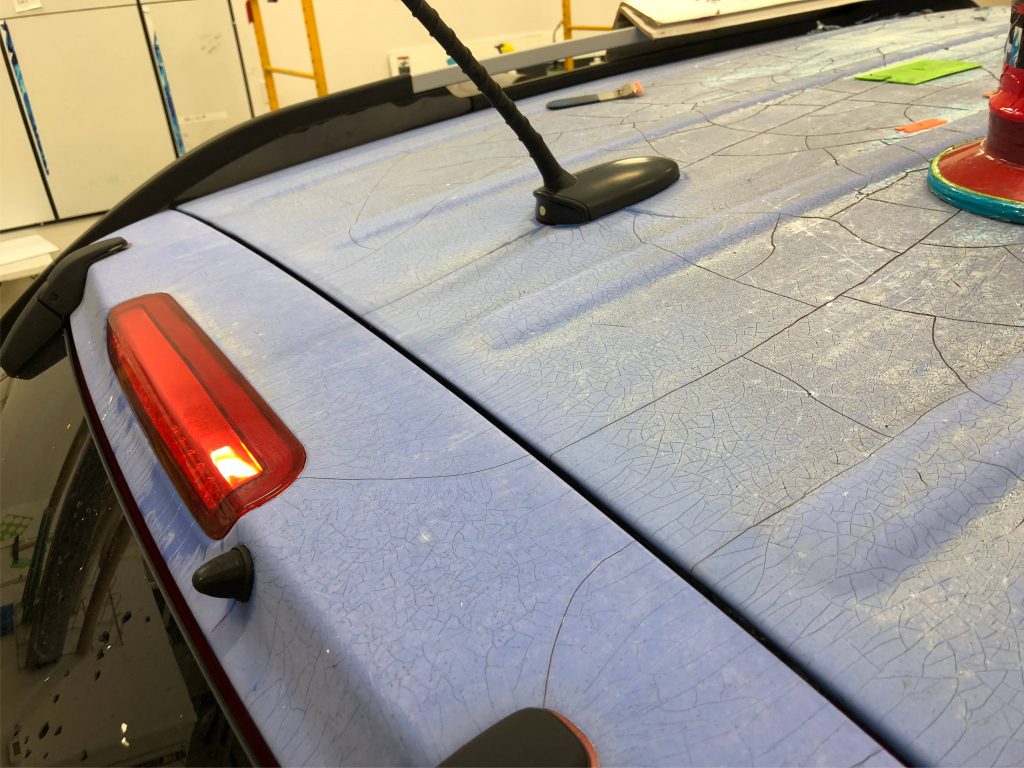Some car wrap buyers would like to believe that their vinyl wrap will last forever. Unfortunately, today’s available materials do not allow for eternal life. Even the highest priced premium brand wrap films have a limited lifespan. Vehicle wrap film longevity does vary by manufacturer, and price point. Most may have a lifespan of between 3 to 8 years. In the end, they all turn into an old car wrap.
So what causes them to “wear out?”
- UV Damage: Yes, that’s right, the sun is the biggest enemy for a vehicle wrap. Ultraviolet light is the primary culprit for inks and pigments to fade over time. That freshly wrapped bright red wrap may very well shift in color over time. If installed past it’s lifespan, that red may look to be on the pink side of the color spectrum.
- Dried Vinyl: When car wraps are newly installed, the material is relatively soft and flexible. This is attributed largely to the presence of plasticizers. These are the chemicals that allow the vinyl to not be brittle. Over time, the plasticizers migrate out of the vinyl which causes it to shrink and crack. This is the most significant attribute to an expensive wrap removal. When the film is dry and brittle, it comes off in rather small pieces. Generally, wraps that are 5 years or less old usually remove with ease- in medium to large sheets. This property does vary by brand. Studies have shown that 3M films are typically require the least amount of effort to remove.
- Atmospheric Pollution: Acid rain is a big culprit for tarnishing the finish on an old car wrap. This damage is usually most visible on gloss finish wraps. Over time, acid rain and other pollutants can dull the finish on overlaminates commonly used in car wraps.
- Road salt and Dirt: Abrasive substances that find their way on to vehicle wrap surfaces may not affect the surface upon contact. These scuffing and scratching agents do their damage any time you make contact with the vehicle (even during washing!) That’s right; Without a perfect pre-wash rinse, you could be “dragging” those abrasives across the surface of the vehicle. Nonetheless, the scratching of the surface usually follows.
So how do I remove an old vehicle wrap? Scroll down to read on.
Get your free Vehicle Wrap quote today at IDWraps.com
National installation and service available near you.
Pictured below is a wrap that was left on the vehicle for years past the suggested durability threshold:

There are a number of techniques that the IDWraps team uses to remove an aged car wrap.
The most common is the same used for all vehicle wraps, but just requires a great deal more “elbow grease” when dealing with an old car wrap. This method is to carefully heat the film and remove by hand. This can be very tedious on dried wraps, as the wrap may come off in very small pieces. Oftentimes, these pieces can be as small as a dime. Imagine how many “dime” sized pieces of vinyl can be on the surface of an entire vehicle. Yes- it would be thousands. A typical vehicle can have over 30,000 square inches of wrapped surfaces. I’d imagine you’re getting it- that wraps should be removed and replaced prior to these conditions.
In situations where the traditional method becomes too laborious, we’ll use our MBX vinyl zapper. Although not a cheap tool, this machine can remove just about any old car wrap. This is not a fast process either. The machine has a serrated rubber wheel that essentially rubs off the vinyl and adhesive from the painted surfaces. Think of it as an eraser that spins real fast and turns the wrap into small chips. The downside of the zapper, is that it does use up pricey consumables. It is common to go through a $40 rubber wheel, every hour that it’s being used.
In the most extreme cases, we may go for the gusto, and use a commercial paint stripper. This solution is for the worst of the worst situations. Use of a paint stripper typically implies that there will be damage to the painted surfaces beneath the vinyl. We typically only use this method when there are no other options. A typical scenario for this technique would be on an old trailer that had a cheap material installed 10+ years ago. A word of caution is that paint damage is expected. This is “paint stripper” after all. The application typically involves brushing on the chemical and giving it dwell time to “eat” the vinyl. Once the film is sufficiently softened up, it is then scraped off. Very often, some paint comes off with the wrap. This method is usually used only when a new wrap is replacing the old installation. Oftentimes, new paint is required to restore the finish- if the surface is not to receive a new wrap.


